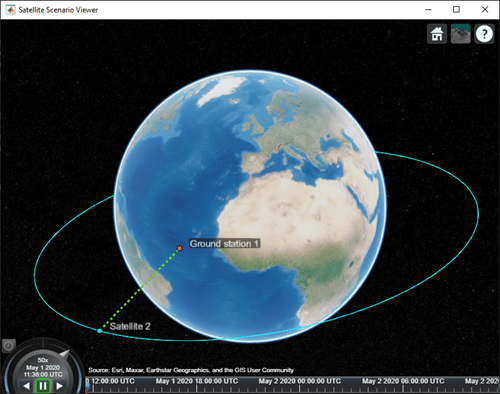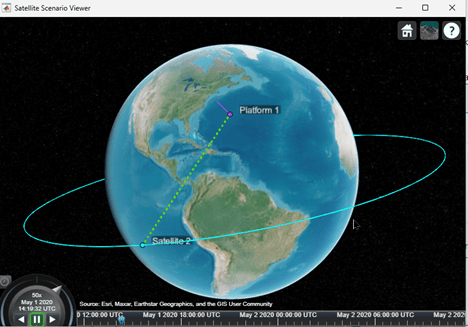accessIntervals
Description
acinterval = accessIntervals(ac)access object in the input vector, ac, is
true.
Examples
Create a satellite scenario and add ground stations from latitudes and longitudes.
startTime = datetime(2020,5,1,11,36,0); stopTime = startTime + days(1); sampleTime = 60; sc = satelliteScenario(startTime,stopTime,sampleTime); lat = 10; lon = -30; gs = groundStation(sc,lat,lon);
Add satellites using Keplerian elements.
semiMajorAxis = 10000000;
eccentricity = 0;
inclination = 10;
rightAscensionOfAscendingNode = 0;
argumentOfPeriapsis = 0;
trueAnomaly = 0;
sat = satellite(sc,semiMajorAxis,eccentricity,inclination, ...
rightAscensionOfAscendingNode,argumentOfPeriapsis,trueAnomaly);Add access analysis to the scenario and obtain the table of intervals of access between the satellite and the ground station.
ac = access(sat,gs); intvls = accessIntervals(ac)
intvls=8×8 table
Source Target IntervalNumber StartTime EndTime Duration StartOrbit EndOrbit
_____________ __________________ ______________ ____________________ ____________________ ________ __________ ________
"Satellite 2" "Ground station 1" 1 01-May-2020 11:36:00 01-May-2020 12:04:00 1680 1 1
"Satellite 2" "Ground station 1" 2 01-May-2020 14:20:00 01-May-2020 15:11:00 3060 1 2
"Satellite 2" "Ground station 1" 3 01-May-2020 17:27:00 01-May-2020 18:18:00 3060 3 3
"Satellite 2" "Ground station 1" 4 01-May-2020 20:34:00 01-May-2020 21:25:00 3060 4 4
"Satellite 2" "Ground station 1" 5 01-May-2020 23:41:00 02-May-2020 00:31:00 3000 5 5
"Satellite 2" "Ground station 1" 6 02-May-2020 02:50:00 02-May-2020 03:39:00 2940 6 6
"Satellite 2" "Ground station 1" 7 02-May-2020 05:58:00 02-May-2020 06:47:00 2940 7 7
"Satellite 2" "Ground station 1" 8 02-May-2020 09:06:00 02-May-2020 09:56:00 3000 8 9
Play the scenario to visualize the ground stations.
play(sc)

Create a satellite scenario.
startTime = datetime(2020,5,1,11,36,0); stopTime = startTime + days(1); sampleTime = 60; sc = satelliteScenario(startTime,stopTime,sampleTime); lat = 10; lon = -30;
Add a platform using the given trajectory in the satellite scenario.
trajectory = geoTrajectory([40.6413,-73.7781,10600;32.3634,-64.7053,10600],[0,2*3600],AutoPitch=true,AutoBank=true); pltf = platform(sc,trajectory);
Add a satellite using Keplerian elements.
semiMajorAxis = 10000000;
eccentricity = 0;
inclination = 10;
rightAscensionOfAscendingNode = 0;
argumentOfPeriapsis = 0;
trueAnomaly = 0;
sat = satellite(sc,semiMajorAxis,eccentricity,inclination, ...
rightAscensionOfAscendingNode,argumentOfPeriapsis,trueAnomaly);Add access analysis to the scenario and obtain the table of intervals of access between the satellite and the platform.
ac = access(sat,pltf); intvls = accessIntervals(ac)
intvls=7×8 table
Source Target IntervalNumber StartTime EndTime Duration StartOrbit EndOrbit
_____________ ____________ ______________ ____________________ ____________________ ________ __________ ________
"Satellite 2" "Platform 1" 1 01-May-2020 14:07:00 01-May-2020 14:54:00 2820 1 2
"Satellite 2" "Platform 1" 2 01-May-2020 17:11:00 01-May-2020 18:01:00 3000 3 3
"Satellite 2" "Platform 1" 3 01-May-2020 20:16:00 01-May-2020 21:06:00 3000 4 4
"Satellite 2" "Platform 1" 4 01-May-2020 23:22:00 02-May-2020 00:11:00 2940 5 5
"Satellite 2" "Platform 1" 5 02-May-2020 02:31:00 02-May-2020 03:15:00 2640 6 6
"Satellite 2" "Platform 1" 6 02-May-2020 05:43:00 02-May-2020 06:22:00 2340 7 7
"Satellite 2" "Platform 1" 7 02-May-2020 08:54:00 02-May-2020 09:33:00 2340 8 8
Play the scenario to visualize the platform and the satellite.
play(sc)

Input Arguments
Access analysis, specified as a row vector of Access objects.
Outputs Arguments
Intervals during which access is true, returned as a table.
Each row of the table denotes a specific interval. The columns of the table are
named Source, Target,
IntervalNumber, StartTime,
EndTime, Duration (in seconds),
StartOrbit, and EndOrbit.
Source and Target are the names of the first and
last node, respectively, which define the access analysis.
If
Sourceis a satellite or an object that is directly or indirectly attached to a satellite, thenStartOrbitandEndOrbitcorrespond to the satellite associated withSource.If
Targetis a satellite or an object that is directly or indirectly attached to a satellite, thenStartOrbitandEndOrbitcorrespond to the satellite associated withTarget. Otherwise,StartOrbitandEndOrbitareNaNbecause they are associated with ground stations.
Note
When the AutoSimulate property of satellite scenario is true, the
access intervals between StartTime
and StopTime
are returned. When the property is false, the access intervals between
StartTime
and SimulationTime are returned.
Version History
Introduced in R2021a
See Also
Objects
Functions
show|play|hide|groundStation|accessPercentage|accessStatus|access
MATLAB Command
You clicked a link that corresponds to this MATLAB command:
Run the command by entering it in the MATLAB Command Window. Web browsers do not support MATLAB commands.
选择网站
选择网站以获取翻译的可用内容,以及查看当地活动和优惠。根据您的位置,我们建议您选择:。
您也可以从以下列表中选择网站:
如何获得最佳网站性能
选择中国网站(中文或英文)以获得最佳网站性能。其他 MathWorks 国家/地区网站并未针对您所在位置的访问进行优化。
美洲
- América Latina (Español)
- Canada (English)
- United States (English)
欧洲
- Belgium (English)
- Denmark (English)
- Deutschland (Deutsch)
- España (Español)
- Finland (English)
- France (Français)
- Ireland (English)
- Italia (Italiano)
- Luxembourg (English)
- Netherlands (English)
- Norway (English)
- Österreich (Deutsch)
- Portugal (English)
- Sweden (English)
- Switzerland
- United Kingdom (English)